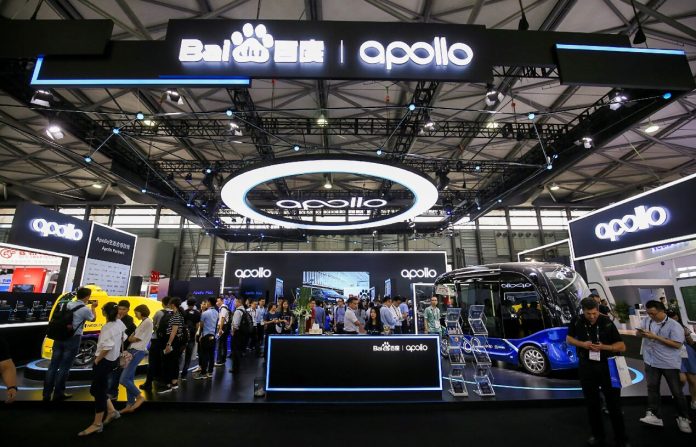On April 22, Baidu Apollo held an intelligent car product launch event in Beijing on the eve of the auto show, focusing on car intelligence and releasing a new upgraded series of “Cockpit Map” products.
Recently, there have been rumors that Baidu Apollo is giving up its L2 assisted driving business, has stopped expanding new customers, and only maintains existing projects. Wang Yunpeng, Vice President of Baidu Group and President of Intelligent Driving Business Group, denied this rumor at the press conference, stating that “(Baidu) insists on being the ‘technical partner’ for intelligentization of automobile companies.
At the press conference, in addition to announcing Baidu Maps V20 version, it officially announced that Baidu Maps’ real car lane-level navigation will soon debut globally on Tesla, causing a wave of attention. Baidu Apollo also released the pure visual city Navigate on Pilot (NOP) driving product ANP3 Pro, claiming that it can bring the hardware costs of advanced urban intelligent driving into the era of ten thousand yuan.
Baidu‘s latest release, ANP3 Pro, adopts a pure visual technology route, equipped with 1 NVIDIA DRIVE Orin (254TOPS), 11 cameras, 3 millimeter-wave radars, and 12 ultrasonic radars. In terms of functionality, ANP3 Pro can cover parking, high-speed driving, urban travel scenes to achieve urban Navigate on Pilot (NOP), high-speed Navigate on Pilot (NOP), automatic parking/remote parking, valet parking AVP, AP/ADAS functions. By the first half of 2024 it will cover 360 cities and by the end of the year it will be able to drive nationwide; in addition, ANP3 Pro is connected to Apollo Smart Driving Cloud for weekly updates.
Compared with the previously delivered ANP3 Max product, the Max has a larger computing space and higher capability limits. It can support many new technologies for future intelligent driving planning, including the popular FSDV12 end-to-end model that has been deployed now, as well as industry-focused L3 regulatory access and mass production. The Max has corresponding capabilities to undertake these tasks and is the best choice for vehicles positioning themselves towards ultimate intelligence.
On the other hand, Pro performs similarly to Max in terms of basic performance for high-speed parking but at nearly half the hardware cost. ANP3 Pro can support new energy vehicle models in the price range of 150,000-250,000 RMB (Chinese Yuan), while Apollo ANP3 MAX equipped with two NVIDIA DRIVE Orin chips (508 TOPS) can support new energy vehicle models priced above 250,000 RMB.
“This also means that ANP3’s advanced intelligent driving products can cover nearly 60% of the current market demand,” Wang Liang said.
Previously, most vehicles equipped with advanced intelligent driving functions were priced at over 300,000 yuan. According to data from the National Information Center, the current penetration rate of advanced intelligent driving equipment in new energy vehicles priced above 300,000 yuan has reached nearly 100%. In order to expand market space, many smart driving companies have targeted the blue ocean of vehicles priced below 200,000 yuan since this year.
DJI Automotive recently announced high-end intelligent driving solutions with system hardware costs of about 5000 yuan and 7000 yuan, expected to be installed on models ranging from 80,000 to 250,000. It also stated that in the future all models will come standard with intelligent driving features, including fuel vehicles. Haomo.ai’s high-end intelligent driving solution has also reached the thousand-yuan level. PhiGent proposed attacking the market for cars priced at around 100,000 in the future.
In response to the phenomenon of price wars among high-end intelligent driving solutions on the market, Wang Liang stated in a media interview that not every product can be called advanced intelligent driving.
He believes that in terms of product definition and evolution speed, Baidu still has differentiation from other companies in the high-level intelligent driving products. In terms of company positioning, each car manufacturer and supplier have their own resource endowment. Expanding market share at low prices is not Baidu‘s strength. Baidu‘s strengths lie in AI, models, and data-driven algorithm levels.
Starting from 2019, Baidu decided to choose a pure visual route in intelligent driving. Since then, a total of three generations of technology solutions have been iterated. In March 2024, the OTA version of the OCC network containing the last part of pure visual technology puzzle was pushed to customer production vehicles. By then, based on BEV+Transformer, the third generation pure visual perception architecture has been completely established, including four basic capabilities: multi-task unified network structure, knowledge detection, mapping building, continuous tracking and scene understanding.
Next, Baidu hopes to track and predict tasks through direct learning. Now, with a large amount of data, it is possible to learn about speed and future motion trends, which basically covers all perception tasks related to autonomous driving. The company refers to this as “Vision Takes AII”.
According to the published data, as of now, Baidu‘s high-level intelligent driving mass production solution has achieved a user penetration rate of 90%, with daily Navigate on Pilot (NOP) driving mileage accounting for 48.2%. In two months’ time, the number of cities opened will reach 360 cities, and by the end of this year all roads in China where Baidu Maps are available will be navigable.

